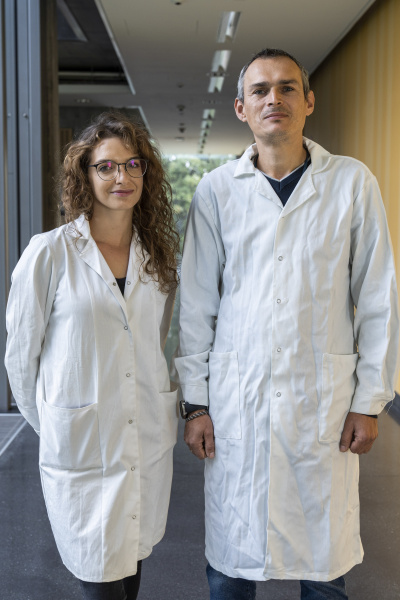
The Polish Patent Office has issued a decision to grant a patent for the invention named ‘Nimesulide salts and method of obtaining nimesulide salt crystals’. The creators of the invention are dr hab. Artur Sikorski, prof. UG and mgr inż. Małgorzata Rybczyńska.
The patent granted to the scientists from the Department of Chemistry concerns new solid forms of nimesulide, a non-steroidal anti-inflammatory drug (NSAID), in crystalline form. Nimesulide is one of the anti-inflammatory, analgesic and antipyretic drugs used in dozens of countries worldwide, available mainly by prescription. It shows higher efficacy than other non-steroidal anti-inflammatory drugs (NSAIDs) in certain conditions.
‘According to statistics, NSAIDs account for approximately 10% of all analgesics, anti-inflammatory and antipyretics prescribed by doctors worldwide. We reach for them when we feel pain, catch an infection, or when we have a fever. They are available in various forms: tablets, granules, patches, gels, ointments, suppositories and more. Millions of people worldwide take them every day and their annual consumption is counted in the thousands of tonnes. The figures quoted are sketchy, as their actual intake is out of strict control - many of them can be bought over-the-counter at almost any grocery shop. However, many people do not realise how many side effects are associated with taking these drugs. The most common are gastrointestinal bleeding, cardiotoxicity, hepatotoxicity and kidney damage,’ says co-inventor prof. UG Artur Sikorski. ‘For the above reasons, activities leading to improvement of physicochemical and pharmacological properties of NSAIDs available on the pharmaceutical market are important. This is what we do in our research conducted in the Crystallochemistry Laboratory at the UG Department of Chemistry - improving the properties of existing drugs by obtaining them in the form of multicomponent crystals in which one of the components is an active substance,' he adds.
Work on the substances that are the subject of the invention took more than five years. The obtained compounds are characterised by better physicochemical properties (including solubility and stability) compared to pure nimesulide, which is an advantage over commercially available pharmaceuticals containing this compound. Among other things, this creates opportunities for different formulations of medicines with this active substance, reduced dosing and longer intervals between doses of the drug. It also has an economic dimension - it is possible that the invention could reduce the cost of manufacturing pharmaceutical products containing this medicinal substance.
Due to the widespread use of non-steroidal anti-inflammatory drugs, the invention has great market potential. Work is currently underway to scale up the compound synthesis process to a semi-technical scale and to develop formulations of the preparations. Some of this research has been funded by the Innovation Incubator 4.0 project, coordinated by the Technology Transfer Office at UG. Efforts were also made to commercialise the invention, which was also the subject of an application to the European Patent Office (EPO).
The invention was among the finalist solutions in the 'EUREKA! DGP - we discover Polish inventions’, edition 2023.
The Technology Transfer Office of the University of Gdańsk supports invention creators throughout the process of patenting the results of scientific research and development works that are created at the University of Gdańsk and their commercialisation.
You can read more about the invention:
on the TTO UG website
on the ‘EUREKA!’ competition website
on the Science in Poland website
